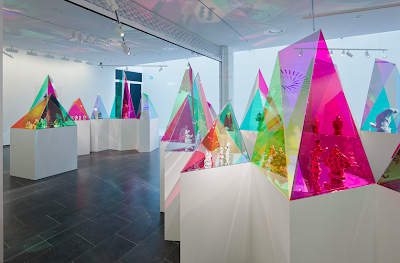Against the background of the exhibition 'Glimpses', the New York based architect Florian Idenburg lectured at at ARCAM, the Centre for Architecture Amsterdam on July 22.
SO-IL is an idea-based design office. With a global reach, it brings together extensive experience from the fields of architecture, academia and the arts. Founders Florian Idenburg and his partner Jing Liu envisioned their New York-based studio in 2008 'as a creative catalyst involved in projects around the world'. During his lecture Idenburg showed successful projects like the installation 'Pole Dance' in MoMA/PS1 in New York, the 'Get It Louder’s' main pavilion in Beijing/Shanghai and the vitrines for a recent exhibition in Amersfoort (NL) on the Meissen-porcelain.
Idenburg started his lecture with mentioning the title of an exhibition in Beijing of recent work by SO-IL: 'To be determined', explaining his work as an open system: the outcome is not predetermined, but develops during the process. But the title could also make you wonder how determined one must be...
During the lecture Idenburg elaborated on this flexible approach which is also a result of the crisis and the changing practice as a result of the global economic downturn and changing society. In fact SO-IL was founded in July 2008, just before the outbreak of the credit crisis. The first assignment, a second home for designer Ivan Chermayeff, failed miserably because of the crisis; Chermayeff lost much of his capital on the stock. Idenburg decided to interview the old man and save it on film. 'The film is almost more important than the project itself,' says Idenburg. 'The story is in fact the project... For us the adventure is important, and we enjoy our work.'
The structure of the 'Get It Louder’s' main pavilion is made out of 56 thin, flexible steel rods that connect at the bottom and the top into two large steel rings. The larger bottom ring frames the interior perimeter of the structure while the smaller top ring creates a skylight; the relationship between the two results in the pavilion’s curvilinear womb-like shape. The structure was assembled within six days on location in Beijing and demounted and reinstalled within a week’s time for its use in Shanghai, showing how absurd practice can get these days.
A typical example of his approach is the Pole Dance system in the courtyard of MoMA/PS1, a flexible structure of surf poles and nets. The visitors were able to hang on and play with the yoga balls above. With the Pole Dance system SO-IL designed a participatory environment that reframes the conceptual relation between humankind and structure. The equilibrium of the interconnected system of poles and nets is constantly affected by human action and environmental factors, such as rain and wind. Upon discovery of its elasticity, visitors engage with the structure to invent games, test its limits or just watch it gently dance. The project shows well how SO-Il tries to reengage the public with the physical environment.
Exhibition on the Meissen-porcelain at Kade, Amersfoort
For Kukje Gallery in Seoul, SO—IL has developed a master plan of the gallery’s 'art campus' in the historic lowrise area in the northern part of Seoul. To soften the rigid diagrammatic geometry of the white cube of the building, a curtain of stainless steel rings has been created. It is meant to form a transition from the actual wall to the surroundings. The pliable veil also produces a layer of diffusion in front of the actual building mass, through a combination of reflection, openness, and the moiré pattern generated through interplay of its shadows.
The building will be completed at the end of the year.
The lecture at ARCAM proved that the office is not only interested in an architecture that reflects and finds new beauty in the uncertainties of this time, but that has in fact found a way to respond to that with an open and flexible architecture. With curiosity we look forward to more work. See for more work the website of SO-IL and check out ARCAM for more information on lectures and debates to come.
Marlies Buurman (ARCAM)




